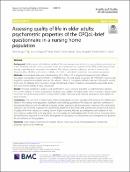Assessing quality of life in older adults: psychometric properties of the OPQoL-brief questionnaire in a nursing home population

View/
Date
2020-01-02Author
Haugan, Gørill
Drageset, Jorunn
André, Beate
Kukulu, Kamile
Mugisha, James
Utvær, Britt Karin S.
Metadata
Show full item recordAbstract
Well-adapted and validated quality-of-life measurement models for the nursing home population are scarce. Therefore, the aim of this study was to test the psychometrical properties of the OPQoL-brief questionnaire among cognitively intact nursing home residents. The research question addressed evidence related to the dimensionality, reliability and construct validity, all of which considered interrelated measurement properties.
Methods
Cross-sectional data were collected during 2017–2018, in 27 nursing homes representing four different Norwegian municipalities, located in Western and Mid-Norway. The total sample comprised 188 of 204 (92% response rate) long-term nursing home residents who met the inclusion criteria: (1) municipality authority’s decision of long-term nursing home care; (2) residential time 3 months or longer; (3) informed consent competency recognized by responsible doctor and nurse; and (4) capable of being interviewed.
Results
Principal component analysis and confirmative factor analyses indicated a unidimensional solution. Five of the original 13 items showed low reliability and validity; excluding these items revealed a good model fit for the one-dimensional 8-items measurement model, showing good internal consistency and validity for these 8 items.
Conclusion
Five out of the 13 original items were not high-quality indicators of quality-of-life showing low reliability and validity in this nursing home population. Significant factor loadings, goodness-of-fit indices and significant correlations in the expected directions with the selected constructs (anxiety, depression, self-transcendence, meaning-in-life, nurse-patient interaction, and joy-of-life) supported the psychometric properties of the OPQoL-brief questionnaire. Exploring the essence of quality-of-life when residing in a nursing home is highly warranted, followed by development and validation of new tools assessing quality-of-life in this population. Such knowledge and well-adapted scales for the nursing home population are beneficial and important for the further development of care quality in nursing homes, and consequently for quality-of-life and wellbeing in this population.
URI
https://doi.org/10.1186/s12955-019-1245-3https://kyuspace.kyu.ac.ug/xmlui/handle/20.500.12504/659
